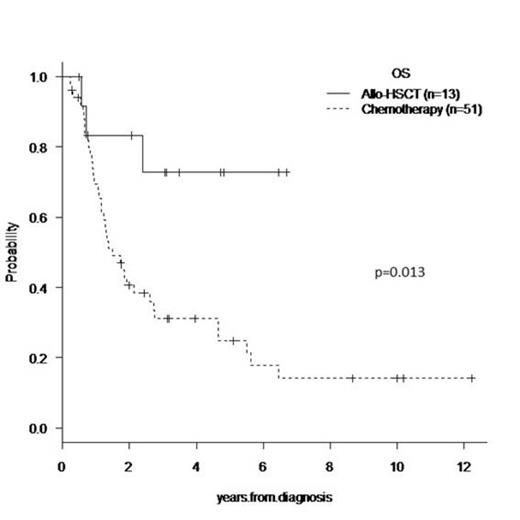Abstract
Recent reports have suggested that allogeneic hematopoietic stem cell transplantation (allo-HSCT) from HLA-matched related donors improves the outcome of elderly acute myeloid leukemia (AML) patients in first complete remission (CR1) (Kurosawa et al BBMT 2011). However, the efficacy of allo-HSCT from alternative donors for the management of elderly AML patients in CR1 remains to be clarified. In this study, we examined the efficacy of allo-HCST for the management of elderly AML patients.
We retrospectively collected the data of consecutive AML patients who were aged 50-70 years and diagnosed in our hospital between January 1, 2000 and May 31, 2013. Patients with acute promyelocytic leukemia (APL) and patients who could not receive intensive therapy or died within 60 days after diagnosis were excluded. The primary endpoint of this study was overall survival (OS), which was defined as the interval between diagnosis and the last follow up. The unadjusted probabilities of OS were estimated using the Kaplan-Meier method. To compare OS between the treatment groups, the log-rank test was used. Multivariate analysis were performed with Cox proportional hazard regression models and 95% confidence intervals (CIs) were calculated.
A total of 131 elderly AML (non-APL) patients were identified. Except for 14 patents, all received chemotherapy. 12 patients who died within 60 days were excluded from the study. Among the remaining 105 patients, 41 could not be induced into complete remission (CR) and showed a dismal outcome; the probabilities of 2 years (2y)-OS were 0% and 4.4% for 5 patients who received allo-HSCT and 36 patients who did not, respectively. In contrast, the probability of 2y-OS of 64 patients who achieved CR1 was 48.5%. Of these 64 patients, 20 proceeded to allo-HSCT. 13 patients were transplanted in CR1, 3 in second CR (CR2), and 4 in relapse. The probabilities of 2y-OS were 56.1% and 45.0% for patients who received and who did not receive allo-HSCT, respectively (p=0.27). When the disease status at allo-HSCT was considered, the 2y-OS of patients who received allo-HSCT in CR1 reached 83.3%, whereas that of patients transplanted in CR2 or relapse reached only 14.3%. Next, we performed univariate and multivariate analysis of OS of patients who achieved CR1. In addition to whether allo-HSCT was performed in CR1 or not, the following factors were also considered as covariates: age and leukocyte counts at diagnosis, cytogenetic classification according to National Comprehensive Cancer Network guidelines, presence or absence of preceding hematological diseases, and the number of induction regimens required for achieving CR1. Univariate analysis showed that allo-HSCT in CR1 was associated with improved OS (2y-OS: 83.3% vs 40.6%, p=0.013) (figure1). Multivariate analysis also showed that allo-HSCT in CR1 was the only favorable prognostic factor for OS (Hazard ratio=0.25, 95%CI: 0.077-0.82, p=0.022). Stem cell sources of allo-HSCT done in CR1 were 1 HLA-matched related donor and 12 unrelated donors including umbilical cord blood from 1 donor.
Allo-HSCT, even from an unrelated donor, improves the outcome of elderly AML patients in CR1. However, allo-HSCT for those with relapsed or refractory disease could hardly extend their survival.
No relevant conflicts of interest to declare.
Author notes
Asterisk with author names denotes non-ASH members.


